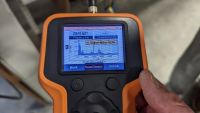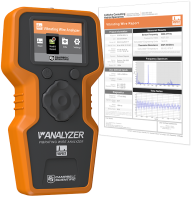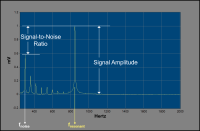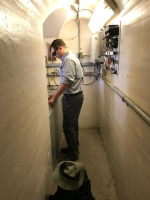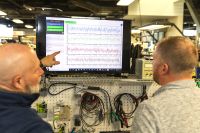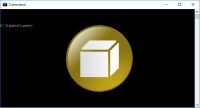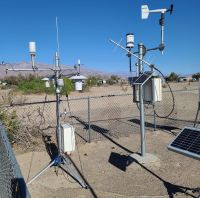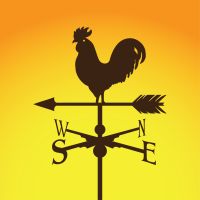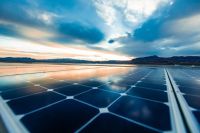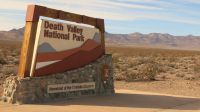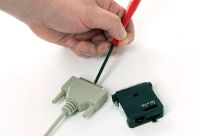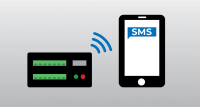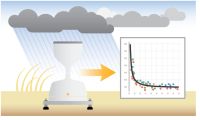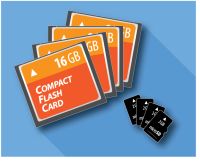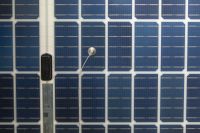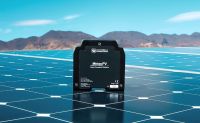Campbell Scientific ブログ 役立つハウツー情報と専門家のアドバイス
Displaying 41 - 60 of 186 articles
長いケーブルでバイブレーティングワイヤーの正確な測定を行う方法
著者: Nathanael Wright | 最終更新日: 10/17/2023 | コメント: 0
通常、バイブレーティングワイヤー測定に長いケーブルを使用すると、信号が弱くなり、干渉の可能性が高くなります。では、この課題を克服し、測定品質を向上させるにはどうすればよいでしょうか?続きを読んでその答えを見つけてください。 Campbell Scientificのバイブレーティングワイヤー測定ハードウェアは、特許取得済みのVSPECT®テクノロジーを採用しており、市場の他のバイブレーティングワイヤー測定システムとは一線を画す優れた性能を備えています。干渉波を除去する能力に加え、VSPECTの高精度な測定により、当社のモニタリングプラットフォームは極めて長いケーブル長のバイブレーティングワイヤー測定を可能にします。 デモンストレーションの実施 この測定結果を検証するため、長いケーブルを用いたデモンストレーションを実施しました。長いケーブルのスプールを用意し、両端を慎重に接続してケーブルを4.2km(2.61マイル)まで延長しました。次に、ワニ口クリップを使用して、スプールの片端の露出したワイヤーにバイブレーティングワイヤー圧力計を接続し、もう一方の端にVWAnalyzerバイブレーティングワイヤーアナライザーを接続しました。 次に、手持ち式 VWAnalzyer を使用して、長いケーブルの長さにわたって一連の測定を行いました。 干渉の導入 4.2km(2.61マイル)のケーブル長で測定に成功した後、測定干渉を発生させ、読み取り可能な範囲の限界をテストすることで、更なるテストを行うことにしました。そのために、AC電源に接続した電動ドリルを使用しました。ドリルを長いケーブルのスプールの横に当て、測定に成功しました。 VWAnalyzerのチャートを観察したところ、VSPECT技術によって測定から顕著な干渉が除去されていることがわかりました。時間領域解析に基づく他のバイブレーティングワイヤーインターフェースを使用していた場合、この干渉が大きな問題を引き起こしていたでしょう。 さらに干渉を大きくするために、ドリルをセンサーの横に置き、測定しながらドリルを動かしました。その結果、天文学的な干渉が生じました。干渉が非常に高かったため、VWAnalyzerは信号対雑音比が非常に低いという警告を出しました。この信じられないほどの干渉にもかかわらず、下の画像から、VWAnalyzerのVSPECT技術によって正確な測定が可能であることが分かります。 結果 まとめると、かなりの干渉波を生じながらも、4.2 km(2.61マイル)のケーブル長にわたって正確なバイブレーティングワイヤー測定に成功しました。当社のお客様の中には、長いケーブル長にわたってバイブレーティングワイヤー測定を行っている方もいらっしゃいます。実際、最長9.66 km(6マイル)のケーブル長で測定を行ったというお客様もいらっしゃいます。バイブレーティングワイヤー測定に長いケーブル長を使用することは最適ではありませんが、このような事例は当社のVSPECT技術の優位性を証明しています。 VSPECT の詳細やバイブレーティングワイヤーアプリケーションのトラブルシューティングについては、以前のブログ記事「バイブレーティングワイヤー圧力計のトラブルシューティング」をお読みください。 ご質問やご意見がございましたら、下記に投稿してください。 続きを読む5 Things a VWAnalyzer Can Do for You
著者: Jacqalyn Maughan | 最終更新日: 08/29/2023 | コメント: 0
You may not realize just how helpful our handheld instrumentation can be—especially when it makes it easy for you to test your vibrating wire sensors, saving you time and money if a failed sensor is identified prior to installation. Let’s dive deeper into the five... 続きを読むVSPECT®を 最大限に活用する
著者: Jacqalyn Maughan | 最終更新日: 08/22/2023 | コメント: 3
VSPECT®の利点を理解することで、この技術を最大限に活用できるようになります。この記事では、このトピックについて詳しく解説し、より良い測定体験をご提供します。 Campbell Scientific の監視プラットフォームが追加のバイブレーティングワイヤーデータを提供するのはなぜですか? 弊社のVSPECTモニタリングプラットフォーム( CR6、CRVW3、AVW200、VWAnalyzer、またはGranite™ VWire 305 )をご利用になったことはありますか? これらのプラットフォームを使用して振動ワイヤセンサーを測定していた際、「他社製品のように2つのデータポイントではなく、なぜ6つのデータポイントが表示されるのか」と疑問に思われたかもしれません。ご安心ください!今回は、各データポイントについて詳しく説明し、VSPECTからセンサーについて何がわかるのかを解説します。 これらの製品をまだ使用したことがない場合は、この記事を読むことで VSPECT の利点を理解し、当社の製品とテクノロジーの使用を検討する際に十分な情報に基づいた決定を下すことができます。 サーミスタ抵抗とセンサー周波数 まず、サーミスタ抵抗とセンサー周波数を見てみましょう。これらは、あらゆるデータ収集システムで得られる2つのデータポイントです。 サーミスタ抵抗に関しては、温度に変換してデータ ポイントとして使用したり、バイブレーティングワイヤーセンサーの温度変化を補正したりすることができます。 さて、最も重要なデータポイントであるセンサー周波数を見てみましょう。これは工学単位(圧力、ひずみ、荷重など)に変換され、センサーを取り巻く環境の変化を測定することができます。 VSPECT対応のモニタリングプラットフォームは、単に周波数を読み取るだけではありません。VSPECTはセンサー周波数を読み取り、センサー信号内の競合する周波数から分離することで、最も正確な測定を実現します。VSPECTを使用することで、電力線、近くの重機、水力発電所などの電気干渉源を除去することで、可能な限り再現性の高いデータを取得できます。 センサー振幅 センサー振幅とは?これは、バイブレーティングワイヤーセンサーのミリボルト応答の二乗平均平方根(つまりセンサー応答の強さ)の測定値です。このデータポイントをセンサーの寿命期間中記録することで、センサーの相対的な健全性に関する概要を把握できます。 例えば、周波数データが不安定であることに気づき、環境がそれほど大きく変化することはあり得ないとわかっている場合などです。センサーを設置した日から今日までのセンサー振幅データをプロットすると、振幅が劇的に減少していることに気づきます。これは、何らかの要因がセンサーの信号強度に影響を与えており、さらなる調査が必要であることを示しています。 ノイズ周波数と信号対雑音比 ノイズ周波数とは、監視プラットフォームが読み取るセンサー信号に影響を与える最も高い電気ノイズ周波数(干渉とも呼ばれます)の振幅のことです。これは、送電線、近くの採掘設備、水力発電所などからの60Hzの干渉が考えられます。また、センサー周波数の整数倍で発生する高調波が原因となる場合もあります。このデータを保存しておくと、センサー測定に影響を与えている干渉源を特定するのに役立ちます。 次に、信号対雑音比(S/N比)を見てみましょう。これは、センサー周波数とノイズ周波数の比です。これは、センサー周囲の電気ノイズが測定にどの程度影響を与えているかを示します。数値が高いほど、ノイズがセンサー信号に与える影響は小さく、数値が小さいほど影響が大きいことを示します。VSPECTは干渉を分離して除去するため、たとえ大きな干渉があっても測定に影響はありません。ただし、他社のモニタリングプラットフォームでは、精度に影響が出る可能性があります。 減衰率 減衰比とは、VSPECTで測定されるバイブレーティングワイヤーセンサーの「リングダウン」のことです。減衰比を時間経過に沿ってプロットすることで、設置後のセンサー環境やセンサー特性の変化を把握できます。これは、センサーの健全性を示すもう一つの指標です。 大きな注意点 このトピックについて議論する際には、覚えておいていただきたい重要な点があります。どのセンサーにおいても、「健全」とみなされる数値や閾値は存在しません。これは、バイブレーティングワイヤーセンサーのメーカーと種類によって異なります。メーカーごとに特性が異なります。つまり、センサーの振幅、信号対雑音比、減衰比など、センサーが正常に機能しているかどうかを判断するための正確な数値や閾値を提示することはできません。しかし、ご安心ください。センサーの検証に役立つデータをご提供し、お客様が自信を持って結果にご満足いただけるよう努めています。 VSPECTを最大限に活用する 当社の VSPECT 対応モニタリング プラットフォーム (CR6、CRVW3、AVW200、VWAnalyzer、および VWire 305) についてお客様にお話しすると、センサーの健全性を確認するために使用されるデータがすでに取得されていることに気付いていないお客様が多くいらっしゃいます。 Campbell Scientific では、あらゆるプロジェクトを成功させるためのツールを提供しており、時の試練に耐えられる長期プロジェクトに携われることに誇りを持っています。 クレジット: Campbell Scientific, Inc. の Michael Adams、Eric Schmidt、Josh Brown がこの記事に貢献しました。 ご質問がある場合は、下記にコメントを残すか、アプリケーション エンジニア ( CSI-Infrastructure@campbellsci.com ) または営業チーム メンバー ( infra-sales-na@campbellsci.com ) までご連絡ください。 続きを読むVSPECT ®を使用した検証:不良センサーか不良データか?
著者: Jacqalyn Maughan | 最終更新日: 04/06/2023 | コメント: 0
振動ワイヤセンサーの測定値が不良なのは、データの不規則性や誤りが原因だと思ったことはありませんか?データの問題が原因ではないかもしれないと知ったら、驚かれるかもしれません。Campbell ScientificのVSPECT®製品ファミリー(CR6, CRVW3, AVW200, and VWAnalyzer)以外のデータ収集システムをご使用の場合、測定値の不良はデータ収集システムの脆弱性が原因である可能性があります。 VSPECT:優れた測定技術 Campbell Scientificでは、センサーが損傷し交換が必要だと考えるお客様から多くのご相談をいただいています。交換は費用と労力がかかる可能性があるため、確実な判断のためにセカンドオピニオンと検証をご希望でした。Campbell Scientificの測定技術を搭載したVSPECTは、センサーの故障か、既存のデータ収集システムが誘導電気干渉の影響を受けているかを判別し、誤ったデータや不安定なデータの原因となる可能性があります。 先日、ある見込み顧客を訪問し、ハンドヘルドVWAnalyzerを用いて、問題がセンサーに起因するものか、それとも他の原因によるものかを調べました。このケースでは、センサーの故障ではなく、データ収集システムの測定性能不足が原因であることが分かりました。このお客様は、グラウト充填されたピエゾメーターとひずみゲージの交換が必要ないことにご満足いただけました。交換すると、100万ドル以上の人件費と時間がかかっていたはずです。 VSPECT は、あらゆる電気的干渉の中から共振センサー周波数を識別します。 重要な監視ネットワークには、正確で再現性の高いデータが必要です。VSPECTの特許取得済み測定およびデジタル信号処理アルゴリズムは、バイブレーティングワイヤーセンサーの基本周波数を正確に特定しながら、あらゆる電気的干渉を排除します。測定から電気的干渉(送電線、水力発電、高周波溶接機、建設機械、電気鉄道などによるもの)を除去することで、精度と分解能の両方が向上します。 CR6 などの VSPECT 対応 Campbell Scientific データ収集製品は、測定から電気的干渉を除去するだけでなく、数十年にわたってセンサーのパフォーマンスを追跡するための診断データを測定して保存できます。 クレジット: Campbell Scientific, Inc. の Michael Adams、Eric Schmidt、Josh Brown がこの記事に貢献しました。 ご質問がある場合は、以下のコメント欄にご記入の上、弊社の営業チームおよびアプリケーション エンジニアまでお問い合わせください。 続きを読むバイブレーティングワイヤー圧力計のトラブルシューティング
著者: Nathanael Wright | 最終更新日: 03/28/2023 | コメント: 0
Campbell Scientificのバイブレーティングワイヤー測定ハードウェアは、特許取得済みのVSPECT®テクノロジーを採用しており、他のあらゆるバイブレーティングワイヤー測定システムに対して明確な優位性を提供します。他社製のバイブレーティングワイヤーインターフェースはパルスカウントを用いてバイブレーティングワイヤー周波数を導出しますが、Campbell ScientificのVSPECTバイブレーティングワイヤー測定製品はスペクトル解析を用いてセンサーの共振周波数を特定し、干渉や競合周波数を除去することで、優れた測定結果を提供します。 優れた技術をもってしても、「センサーが反応しない?配線が切れたり壊れている?干渉が激しい?」といった質問に答えるのが難しい場合があります。 これらの質問に答えるために、測定値を確認するために使用する 6 つのパラメータを以下に示します。 センサー周波数 振幅 信号対雑音比 ノイズ周波数 減衰率 サーミスタ 当社のVSPECTバイブレーティングワイヤー測定製品はすべて、これらの値を読み取ることができます。CR6, CRVW3, Granite™ VWire 305, AVW200 , VWAnalyzerなどです。本稿では、ダウンロード可能な Device Configuration Utilityを搭載したCR6データロガーを使用します。 まず、Device Configuration Utilityを使用してデータロガーに接続します。接続後、一番上の行にある「VW Diagnostics」タブを選択します。 下の画像はVW Diagnostics タブです。中央には、これから使用する診断値を入力する6つのフィールドがあります。ピーク周波数(センサー周波数)、ピーク振幅(振幅)、信号対雑音比、ノイズ周波数、減衰率、サーミスタです。診断テストを実行すると、これらのフィールドの上下のスペースにグラフが表示され、情報を視覚的に把握するのに役立ちます。 CR6が測定を行うと、2つのグラフと6つのフィールドの情報が自動入力されます。データロガーに設定されている測定間隔によっては、データロガーが測定を行うまでに遅延が発生する場合があります。その場合は、データをファイルに保存し、後でダウンロードできるようにデータロガーを設定してください。このファイルは、技術者に解析の支援を依頼する場合にも役立ちます。 では、そのプロセスを見ていきましょう。 まず、ウィンドウの右下にある「SetUp」をクリックします。VW診断セットアップウィンドウが表示されます。 CR6で診断ファイルを生成するように設定するには、「VW Diagnostic Variable」ドロップダウンボックスをクリックし、適切なファイル名を選択します。「VW Drive」ドロップダウンボックスで、ファイルを保存するデータロガーのストレージドライブを選択します。 注: これら 2 つのフィールドは事前に入力されていますが、 [OK]ボタンが使用可能になる前に、有効なファイル名と場所を入力するなど、各フィールドで選択を行う必要があります。 「OK」をクリックします。データロガーはセンサーを測定し、画面にデータを表示し、データロガーのファイルシステムに保存します。測定が完了すると、選択したドライブにファイルが書き込まれ、ファイル名がFile Controlに表示されます。 このファイルは、File Control 経由でダウンロードするか、 VW Diagnostics タブから[Save These Results(これらの結果を保存)]または[Export(エクスポート)]をクリックしてエクスポートすることができます。 「Save These Results(これらの結果を保存する)」を選択した場合は、ファイルを後で見つけやすい場所に保存してください。ファイルの末尾に.vw拡張子が付いていることに注意してください。このファイルには、ライブウィンドウに表示されるものと同じスペクトルと時系列データが含まれており、Device Configuration UtilityのVWオフライン解析モードを介してどのコンピュータでも開くことができます。 または、「Export」をクリックすると、別の種類のファイルを保存するように求められます。必ず分かりやすい場所に保存してください。ファイルの末尾に.txt拡張子が付いていることに注意してください。このファイルは後でテキストエディタで開き、CR6の測定値を確認できます。 診断から得られる情報を最大限に活用するには、毎回両方のファイルを保存することを検討してください。ただし、このブログ記事では、オフラインモードでグラフ化されたデータを確認できるように、.vw 拡張子のファイル(Save These... 続きを読むEasily Diagnose CELL2XX Cellular Modem Connection Issues
著者: Nathanael Wright | 最終更新日: 01/12/2023 | コメント: 4
Campbell Scientific’s CELL2XX cellular modems (CELL205, CELL210, CELL215, CELL220, and CELL225) are commonly used as a low-power alternative to the many industrial cellular solutions available on the market today and are built to easily interface with all Campbell Scientific data loggers and data-acquisition systems. Occasionally,... 続きを読むHow to Install DevConfig on Multiple Computers Quickly and Easily
著者: Nathanael Wright | 最終更新日: 10/18/2022 | コメント: 3
Setting up software on multiple computers can be a chore. If you need to install the Device Configuration Utility (DevConfig) on several desktop computers or service laptops, the unattended or silent install process may make it significantly quicker and easier. This article covers the simple... 続きを読むHow to Generate SFTP Keys Easily
著者: Nathanael Wright | 最終更新日: 09/12/2022 | コメント: 12
As organizations throughout the world continue to strengthen their network and data communications systems to counter increased security threats, we’ve noticed a trend: there’s been an increase in the number of Campbell Scientific customers setting up secure communications between their data loggers and other devices. SSH... 続きを読むDeath Valley, a Year Later
著者: Dirk Baker | 最終更新日: 07/29/2022 | コメント: 9
About a year ago (May 2021), I installed a weather station next to the National Weather Service’s (NWS) official station at Furnace Creek in Death Valley National Park (California, USA). To familiarize yourself with this project, read my previous article. The purposes of this installation... 続きを読むSimplify Your Sensor Installation Using Wind Direction Offsets
著者: Jacob Davis | 最終更新日: 06/13/2022 | コメント: 0
As you may know, it can be quite challenging to perfectly align the north mark of a wind direction sensor with true north. For example, when you’re on a ladder handling tools or hanging on a tower, you don’t have a spare hand to hold... 続きを読むWhich surface temperature sensor is best for your application?
著者: Libbie Anderson | 最終更新日: 05/05/2022 | コメント: 0
At Campbell Scientific, we redesigned our back-of-module temperature sensors and launched the CS241 and CS241DM purpose-built sensors to optimize performance on bifacial photovoltaic (PV) modules and help you collect data as precisely as possible. These newer sensors have some similarities to our previous sensor models, but... 続きを読むBut It’s a Dry Heat… like a Furnace
著者: Dirk Baker | 最終更新日: 06/21/2021 | コメント: 6
In this article, I'll share my experience collaborating on a research project to record some extreme weather conditions that may even set a world record! On August 16, 2020, the weather station located at Furnace Creek in Death Valley National Park (California, USA) recorded a temperature... 続きを読むHow to Test COM Ports and Short Haul Modems
著者: Bruce Smith | 最終更新日: 04/15/2021 | コメント: 2
Has an electrical surge or other event made you concerned that your COM port or short haul modem may not be operating properly? Do you know how to test for this? In this brief article, we’ll look at some simple tests you can perform to... 続きを読むWhat You Should Know: Improvements to SMSSend()
著者: Dana Worley | 最終更新日: 04/09/2021 | コメント: 0
Do you currently use SMSSend() in a CRBasic data logger program to send SMS messages through a Campbell Scientific CELL2XX internal or external cellular module? There are some things you should know about the recent improvements we made that affect how SMSSend() works. With the release... 続きを読むWhy Do We Need an Algorithm for Rainfall Intensity Correction?
著者: Dirk Baker | 最終更新日: 03/05/2021 | コメント: 0
In this article, I’ll explain how errors can occur when measuring the precipitation amount, discuss a correction approach, and demonstrate how an algorithm can be used to design high-quality tipping bucket rain gauges. Introduction Liquid precipitation (rain) is at once one of the simplest measurements mechanically and... 続きを読むPick a Memory Card, but Not Just Any Memory Card
著者: Carolyn Ivans | 最終更新日: 10/23/2020 | コメント: 0
You may already know that you can add external data storage to your data logger with flash-memory cards. But do you know what kind of card you need—or if you even need one? In this article, I’ll answer these and other memory card questions. In... 続きを読むAnswers to 5 Common Questions about Storing Data to Memory Cards
著者: Carolyn Ivans | 最終更新日: 10/22/2020 | コメント: 5
You may use CompactFlash or microSD memory cards for external storage of your data logger data, but are you using your cards correctly? In this article, I’ll answer some common questions you may have about memory card usage. Recommended for You: If you haven’t done... 続きを読むMonitoring the Performance of Bifacial Solar PV Panels: Challenges and Opportunity
著者: Ajay Singh | 最終更新日: 10/13/2020 | コメント: 0
When we are faced with challenges, there is often an opportunity for improvement. In this blog article, learn how our engineers redesigned our back-of-module (BOM) temperature sensor to resolve specific challenges that impacted the quality of bifacial solar photovoltaic (PV) panel performance monitoring. Bifacial PV panels... 続きを読む電磁ノイズの高い環境でバイブレーティングワイヤーの測定を行う方法
著者: Timothy Jeppsen | 最終更新日: 10/07/2020 | コメント: 0
1997年、私は初めてバイブレーティングワイヤー圧力計を用いて地下水位の変動を計測しました。ある大手エンジニアリング会社が、サンバーナーディーノ山脈を横断する大規模パイプライン建設工事が地下水に影響を及ぼすのを防ぐため、水位を監視していました。私は、ピエゾメータの計測用に、 CR10XデータロガーとAVW100バイブレーティングワイヤーインターフェースの設置を依頼されました。CR10Xのデータは、携帯電話モデムを介してエンジニアリング会社に送信されていました。 8地点からのデータは定期的に送信されており、山を貫くトンネル建設が始まるまでは良好に見えました。しかし、トンネル掘削重機の電磁ノイズがバイブレーティングワイヤーセンサーに到達すると、測定値はノイズに埋もれてしまいました。ノイズによって測定値が範囲外に大きく変動したため、水位の変化を検知することができませんでした。 バイブレーティングワイヤーセンサーは、長期間の設置において非常に高い精度と安定性を示すことが知られていたため、当初このプロジェクトに選定されました。しかし、外部からの電磁ノイズの影響を非常に受けやすいことも判明しました。 時間領域解析 監視装置が設置された当時、バイブレーティングワイヤーセンサーの読み取りには時間領域解析が用いられていました。AVW100はセンサーワイヤーを励起し、所定の数の正傾斜ゼロクロス間の平均時間を測定することで、ワイヤーの共振周期を求めます。共振周波数は共振周期の逆数です。時間領域解析は、すべてのメーカーがバイブレーティングワイヤーセンサーを測定する際に採用している従来の方法です。 バイブレーティングワイヤーセンサーを測定するこの方法は、低ノイズ環境では非常に有効です。しかし、ノイズの多い環境では、センサーの測定値がノイズに埋もれてしまいます。 スペクトル分析 2008年、Campbell ScientificはバイブレーティングワイヤーアナライザモジュールAVW200およびAVW206を発表しました。これらのモジュールは、バイブレーティングワイヤーセンサーの測定に特許取得済み*のスペクトル解析技術を採用しており、電磁ノイズを除去します。 スペクトル解析アプローチは、励起されたワイヤーの応答を時間ではなく周波数の関数として解析します。このアプローチはノイズを除去するだけでなく、測定精度も向上させます。バイブレーティングワイヤーセンサーのメーカーは、共振周波数の変化を通常0.1Hz単位で測定します。ノイズがない場合、時間領域法では0.01Hz rmsの測定精度が達成されますが、スペクトル解析では0.001Hz rmsの測定精度が達成されます。 バイブレーティングワイヤースペクトル分析技術(VSPECT ®) 特許取得済みのVSPECT技術は、Campbell Scientificの複数の製品で利用可能です。これらの製品の詳細については、以下のリンクをクリックしてください。 CR6 計測・制御データロガー Granite™6 計測・制御データ収集システム Granite™ VWire 305 ダイナミックバイブレーティングワイヤーアナライザー CRVW3 チャンネル バイブレーティングワイヤーデータロガー VWAnalyzer バイブレーティングワイヤーアナライザー (手持ち式フィールドレポートツール) AVW200 倍部レーティングワイヤーアナライザーモジュール 当社の特許取得済み VSPECT テクノロジーの詳細については、VSPECT Essentials Web リソースをご覧ください。 *動的バイブレーティングワイヤー測定技術は、米国特許第8,671,758号により保護されており、バイブレーティングワイヤースペクトル分析技術(VSPECT)は、米国特許第7,779,690号により保護されています。 続きを読むWhy Data-Acquisition Systems Are Key Elements to Solar Projects
著者: Libbie Anderson | 最終更新日: 09/21/2020 | コメント: 2
Solar photovoltaic (PV) monitoring projects often use a variety of sensors to gain information about the site performance and its available resources. To obtain this information, solar-monitoring sensors need to be connected to a database that can collect, evaluate, visualize, and interpret data from all... 続きを読む











